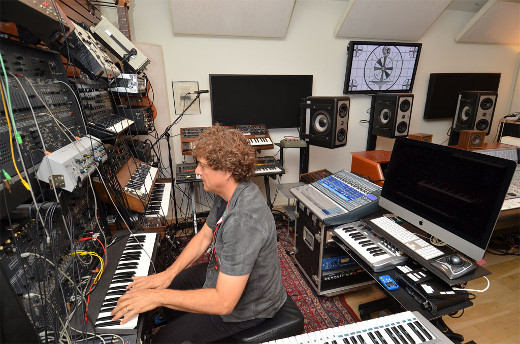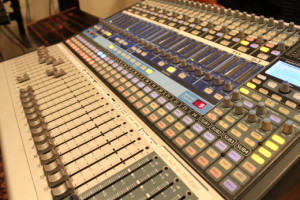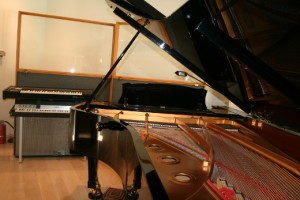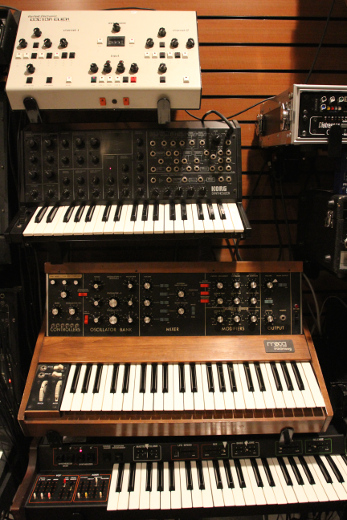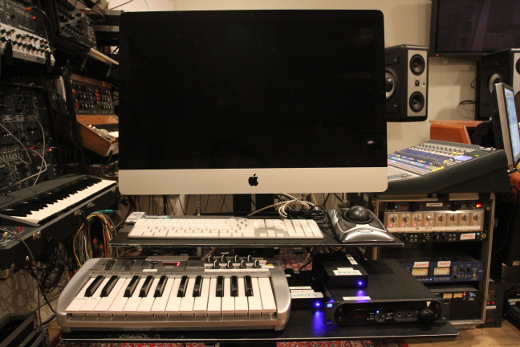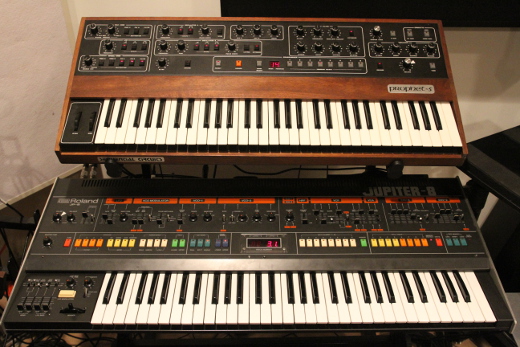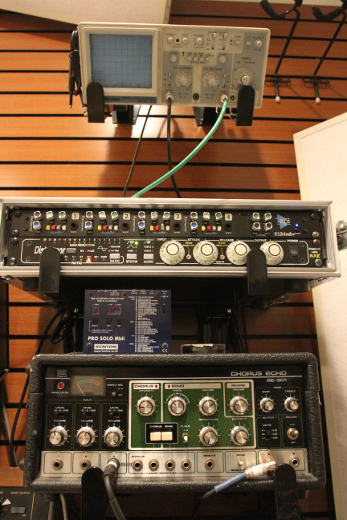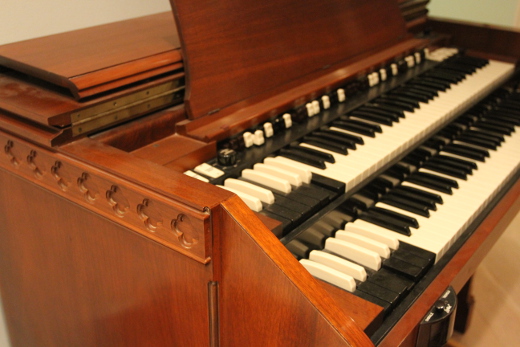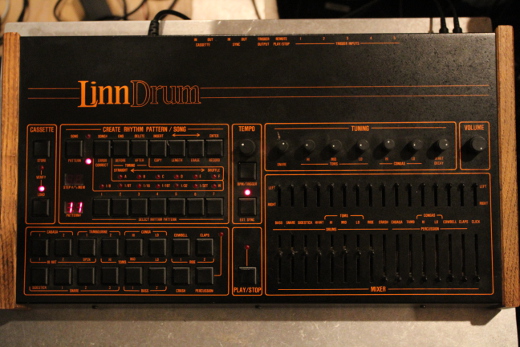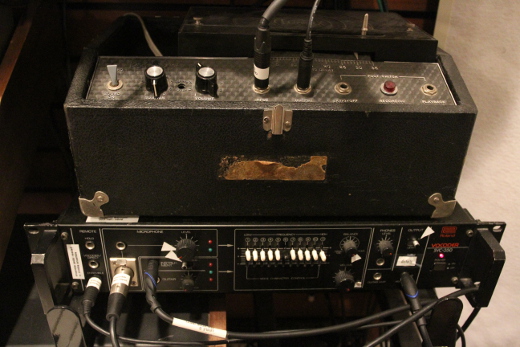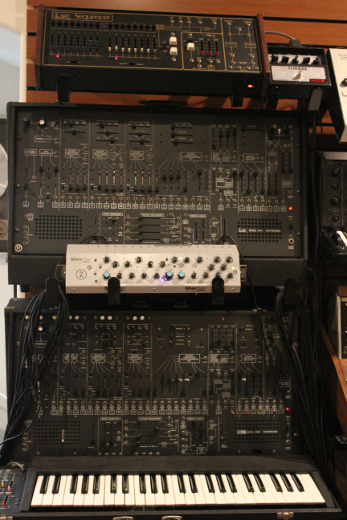Composer Cribs: Anthony Marinelli — Los Angeles
Seeking synth heaven? You’ll find a pocket of paradise at the studio of Anthony Marinelli in Los Angeles.
Packed with analog synths, this is no keyboard museum. Marinelli puts it all to good use, and this constantly curious composer has got plenty to keep him busy. First off there’s thousands of commercials in his portfolio, including 30+ Apple Computer spots, and clients including Microsoft, Nike, Mercedes-Benz, Jaguar, Budweiser, and even the “This Is Your Brain on Drugs” campaign.
And then there’s the movies. If you’ve seen Hotel, American Gun, Young Guns, Internal Affairs, Timecode, Leaving Las Vegas, Demolition Man, Let It Ride, and Planes, Trains & Automobiles, then you’ve heard what he can do.
It all comes down to a smartly designed studio, an outstanding assemblage of gear and instruments, and a sharp sense of when to delegate authority. Not to mention a willingness to share the secrets of his success — which he does without further ado below.
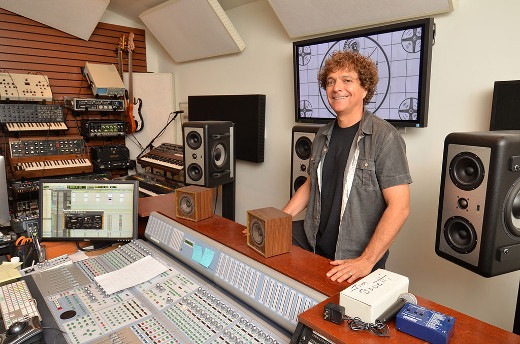
Enjoying the experience: Anthony Marinelli, a bounty of Barefoots, and a mean synth stack. (Photo Credit: David Goggin)
Composer Name: Anthony Marinelli
Website: anthonymarinelli.com
Location: Los Angeles, CA
Soundtracks Served: I started my professional career as a teenager playing synthesizers for records and movie sessions. During that time I also co-founded a synthesizer group called the Synners. We performed Classical works such as Beethoven’s 8th Symphony, Tchaikovsky’s Romeo and Juliet Fantasy Overture, some Bach Organ Works, exclusively with synths such as 2 Yamaha CS-80’s, 2 ARP 2600’s, ARP 2500, Prophet 5, Mini Moog and a Tascam 80-8 tape machine.
Our live radio broadcasts got the attention of some movie producers and established Hollywood composers that asked us to program, orchestrate and perform on their films.
Those credits, along with working on Thriller with Michael Jackson, created opportunities to write music for my own projects. I composed hundreds of television ads covering almost all musical genres. This gave me extensive experience to regularly work with string quartets, large orchestras, ethnic instruments, Zydeco bands, choirs, you name it.
I began formally studying conducting since I was primarily working with acoustic instruments for my feature films during this period. I’m still not sure why, but I sent all my analog synths into storage. I didn’t even see them for about 10 years. I now use them every day. They are hard-wired to my console so I can play and record all of them in real time. They are well maintained and sounding better than ever, and I’m back to preforming live with them as well.
Over the last two years I’ve been co-creating BollyDoll, a Broadway musical with songs, score, effects, dance and animation. Working in all these genres has had a profound influence on how I perceive creativity, music, sound, technology and it’s artists.
Clients/Credits: Young Guns, 2 Days in the Valley, 15 Minutes, Thriller – Michael Jackson, “BollyDoll” – currently co-creating with Amrita Sen (Broadway musical, animated feature film, workout video, fashion….)
Big Premiere: I designed and built my first commercial recording studio in 1977 in the pool room at my mom and dad’s house. In 1981, the room was upgraded with a New England Digital Synclavier II, a 3M Model 79 – 24 track analog tape machine with a Trident mixing desk. I used Dolby SR noise reduction for the films. The last version of that room had a Sony 3324 Digital tape machine and a Synclavier Direct to disk system.
I moved everything to a commercial building in Hollywood in 1984 and stayed there for the next 23 years. I ultimately restored the building’s interior/exterior to its original 1913 Art Deco style including a billiard room, poker parlor and commercial kitchen. It was the home for my music operation and my mixing facility Levels Audio Post. The studios were outfitted with a lot of gear that shared a central machine room. We operated with a staff of about 12 employees between the 2 companies. We could deliver pretty much any type of audio content from original music, sound design, television mixing, sound effects, VO recording/editing to final film mix on my dub stage.
Analog Inspiration: I’ve always required my studio designs to consider the contribution of musicians, singers and engineers.
I compose music either in my head or with a pencil on paper. My approach is to take those abstract ideas and determine what tools will best make those musical ideas come to life. So I decide on the software or the people I need after the music is written. I learn about the latest technology available to me much like a conductor learns about all the instruments in the orchestra.
The conductor, however, doesn’t spend his time performing them all. I rely on the experts for that. Consequently, I have always employed a full-time recording engineer. This process keeps my creativity free of conforming to any particular process, including any given DAW. I’ll use whatever new or old techniques it takes. We have so much sound power available to us these days by incorporating old and new. We can blend acoustic instrument performances, soft synths, plugin effects, analog effects, quantization, live feel and hand-drawn dynamics.
The magic that happens when collaborating with great artists, rhythm sections, orchestrators, producers, directors, soloists is of utmost importance to me, so I try to keep the atmosphere of the studio inviting to its guests.
Key Personnel: Beau Bonetti has been my full time First Engineer on most projects over the last four years. He is a master of so many concerns at the studio including: recording, mixing, fixing, live performance, back catalog, video and computers. He of course always offers valuable creative input.
Beau Chimes In On What Anthony Needs From His Engineer: Beau — In a few words, speed and transparency.
I keep waiting for the day when Anthony says I’m too fast. His musical mind is so rapid that I’m constantly trying to find ways to make our setup and workflow more efficient and the technical concerns less restrictive. We used to have a one-computer setup which did have its benefits, but our new two-computer setup allows us both to be working at the same time in a session. Anthony can spend time getting a new sound while I’m making the existing mix work.
And if one computer crashes (which never happens lol) the other one isn’t affected. It’s a very common setup for a reason. Also, we’ve got a mix-as-you-go approach. Everything is additive. So the mix is constantly evolving and being reworked as the idea develops. But in the end my most important responsibility is to capture the performances and ideas before they disappear.
Transparent Workflow: Anthony — My main instruments are a Yamaha CF III, 2 ARP 2600’s, ARP Sequencer, Mini Moog, Jupiter 8, Prophet 5, MS-20, Fender Rhodes, Hammond C3, Clavinet/Pianet Duo, Roland Space Echo, Echoplex, and lots of vintage guitar pedals.
They are all wired up via a PreSonus Studio Live 24.4.2 so I can hear/play any of them in real time. My virtual instruments are on a loaded up iMac with a big screen. I have a lot of loop libraries, sample performing libraries, software synths and effects plugins onboard.
I’ll usually hand-play my performances with the engineer running the transport on either Pro Tools, Ableton Live or Logic depending on the required task. I program and sculpt my own sounds before my engineer records the performance. He will then do his own thing to the performances with his rig later in the chain.
My favorite “machine feel” performing hardware is the Dr. Click. It allows me to fire sounds via converting the session click track into two channels of clocked gates, triggers, control voltages, LFO’s with any rhythmic subdivisions of the click. I will sometimes play the pitches on the keyboard while the Dr. Click is actually triggering the sound. I’m able to achieve spontaneous and endlessly long sequencer patterns this way.
My engineer will typically handle all the final recording and mixing in Pro Tools with an Avid D Command. He’ll record through my Neve, API, Pendulum and Grace preamps incorporating his selection of effects plug-ins at the mix stage. We monitor with a very fine 5.1 Barefoot Speaker array.
Listen In: Before I got the Barefoots, I had four pairs of very high-definition monitors. I had eight of them, because I rotate them into the 5.1 arrays I’ve had since I bought the first pair from Michael Jackson. They were his speakers and I just liked them and never could find any replacements.
Then the Barefoot MM27’s showed up after about 20 years and they were the first speakers that truly spoke to me and said, “I’m your new speakers.” The sound of the Barefoots translates the best. It doesn’t hype the sound when I’m recording. It gives me the full audio spectrum from lows to highs. They’re very quick. The transients are very rapid.
I deal in a lot of different genres of music and it’s not like I use a certain kind of speaker for one kind of music and another kind of speaker for another. It’s across the entire spectrum. My analog synthesizers have very sharp transients and deliver sub sonic force. Orchestral recordings require speakers to define subtleties across a wide spectrum. In the end, the speakers are what everyone hears. If we don’t screw up the music or the mix, I can always count on the Barefoot’s to deliver noticeable star power.
Picture This: We project video on a 20’ white wall for cinematic playbacks and for our dancers to use as a backdrop set. I use a standard plasma display of extended desktop for scoring to picture.
Audience Accommodations: I make sure that every recording session and music playback is an entertaining show for the musicians, director, the studio, the producers and of course for me too!
The atmosphere is very important to me since I’m recording performances. I like capturing exciting and emotional moments “on tape”. We all go home happy that way.
Complex Cue: BollyDoll, my current project requires every ounce of creativity I have.
My co-creator Amrita Sen and I are integrating story, music, lyrics, animation, dance choreography, costume design, new theatrical technology along with in store merchandise that she designs. She is a gifted fine artist, lyricist, singer, storyteller and conceptual artist. The project demands excellence, so I push myself pretty hard.
The music and lyrics must tell a narrative story over 90 minutes, but still breakdown into a collection of individual pop songs. We are learning new animation software, audio software, live show production, TV production, always something new. We often require (or discover by accident) more efficient work flows to meet the projects evolving needs as we exploit new categories such as a workout video.
This project takes sound and video from a 2-dimensional space to a 3-dimensional space. The technical concerns expand exponentially.
Priceless Advice: Work hard and learn something new each day so you keep getting better. Keep your personal and family relationships as healthy as possible. Take care of your ears and your overall health. Listen to everyone, but do your own thing after making sure you’ve listened to yourself. Talk to old composers and musicians, they can save you some time (and money). Triple back up your hard drives often and spin them up at least every 6 months. Keep the drama in your music and out of your life!
— Anthony Marinelli
Please note: When you buy products through links on this page, we may earn an affiliate commission.









